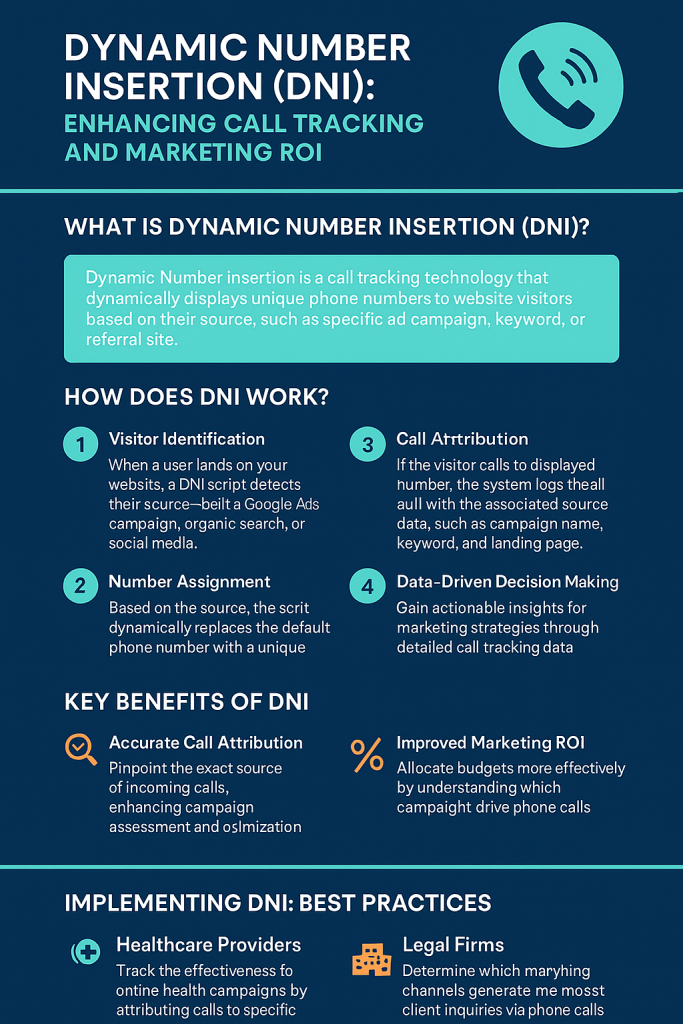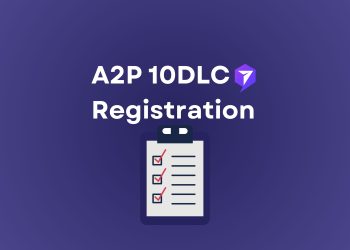Knowing how customers move through your site is key in today’s digital world. Online actions like clicks and form fills are easy to track. But phone calls, a big way people convert, are often missed. Dynamic Number Insertion (DNI) helps by linking calls to marketing efforts, giving a full view of campaigns’ performance.
What is Dynamic Number Insertion?
Dynamic Number Insertion is a call tracking tool. It shows unique phone numbers to website visitors based on where they come from. This could be an ad, a search term, or a referral site. When someone calls that number, the system tracks the call back to the marketing source, showing how offline actions match up with online efforts.

How Does Dynamic Number Insertion Work?
- Visitor Identification: When someone visits your site, a DNI script finds out where they came from. This could be an ad, a search, or social media.
- Number Assignment: The script then changes the default phone number to a unique one based on the visitor’s source.
- Call Attribution: If the visitor calls the new number, the system logs the call and records the source, such as the campaign name or keyword.
- Data Integration: This information then goes into analytics tools like Google Analytics and CRM systems, giving a complete picture of marketing performance.
Key Benefits of Dynamic Number Insertion
1. Accurate Call Attribution
DNI gives unique numbers to different marketing channels. This lets businesses see exactly where calls come from. This detail helps improve campaign planning and performance.
2. Improved Marketing ROI
Knowing which campaigns get calls helps marketers budget better. They can focus on what works and cut back on what doesn’t.
3. Enhanced Customer Experience
DNI can send calls to the right department. This means customers get the right help fast, making the experience better.
4. Data-Driven Decision Making
With detailed call data, businesses can make smarter choices. This includes improving marketing, training staff, and providing more intelligent customer service.
Implementing Dynamic Number Insertion: Best Practices
- Choose a Reliable DNI Provider: Pick a provider that works well with your systems and offers good DNI features.
- Configure Tracking Numbers: Use different tracking numbers for each marketing channel. This lets you track each campaign’s performance accurately.
- Set Up Triggering Conditions: Decide when to show different numbers. This could be based on location or search terms.
- Integrate with Analytics Tools: Make sure your DNI system works with tools like Google Analytics and CRM systems. This will help you analyze data fully.
- Test Your DNI Setup: Test your DNI setup on different devices and browsers. This ensures it works smoothly before you launch it.
Real-World Applications and Case Studies
Many businesses have used DNI to boost their marketing. For example, a dental practice tracked its digital marketing’s success. They saw a big jump in patient calls and better use of their marketing budget. Knowing which campaigns worked best, they could focus on those for better results.
Common Challenges and How to Overcome Them
1. Technical Implementation
Setting up DNI requires some tech know-how. To overcome this, work closely with your web team or choose a DNI provider that offers excellent support and guidance.
2. SEO Considerations
Changing phone numbers can affect SEO if not done right. Use JavaScript to swap numbers and ensure search bots see the same phone number. This keeps your SEO strong.
3. Data Privacy Compliance
You must follow data privacy laws when collecting and storing call tracking data. Make sure your DNI setup meets these rules. Also, tell users how their data is being used.
Conclusion
Dynamic Number Insertion is a key tool for better call tracking and marketing results. It helps businesses link online actions to offline sales, leading to smarter marketing and happier customers.
Frequently Asked Questions (FAQs)
1. What is Dynamic Number Insertion (DNI)?
Dynamic Number Insertion (DNI) is a call tracking tech. It shows unique phone numbers on websites based on where visitors come from. This helps businesses know which ads or sites are getting calls.
2. How does DNI work?
DNI uses JavaScript code on your site. It changes the phone number to a unique one based on where the visitor is coming from. When they call, it logs the call and where it came from, helping to track it.
3. Why is DNI essential for marketing ROI?
DNI provides detailed information on which marketing is working. This helps marketers improve their strategies and use their budgets more effectively, boosting the return on investment (ROI).
4. Can DNI track keyword-level data?
Yes, DNI can track data down to specific keywords. This is super helpful for improving paid search ads and understanding what customers are looking for.
5. Does DNI affect SEO?
When done right, DNI doesn’t hurt SEO. Search engines see the default number, keeping your site consistent and avoiding SEO penalties.
6. Is DNI compliant with data privacy regulations?
DNI itself doesn’t collect personal info; it tracks where visitors come from. However, make sure your data handling meets GDPR or CCPA rules.
7. Can DNI be used on multiple websites or subdomains?
Yes, DNI works on many sites and subdomains. You can track and attribute calls across your entire online presence with the proper setup.
8. How many tracking numbers do I need for DNI?
The number of tracking numbers needed depends on your site’s traffic and the number of sources you want to track. Busy sites or those with many campaigns might need more numbers for accurate tracking.
9. Can DNI track calls from offline sources?
While DNI is mainly for online tracking, some systems also let you track offline ads. This allows you to see how offline efforts are performing.
10. What are the common challenges in implementing DNI?
Setting up DNI can be tricky, especially with technical stuff. You must also ensure numbers swap correctly and work with your analytics tools. Getting help from experts and following best practices can help solve these problems.













